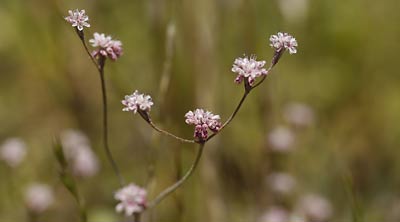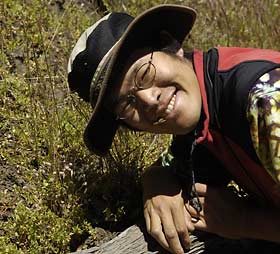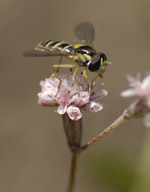UC Berkeley Press Release
 Mount Diablo buckwheat, with its characteristic branched flowers, grows along the edges of chaparral, in areas that have been partly cleared of grass by rabbits. (Photos by Scott Hein / Save Mount Diablo) |
Dainty pink Mt. Diablo buckwheat rediscovered
BERKELEY – A petite pink flower that hasn't been seen in 70 years has been rediscovered on the flanks of Mount Diablo in Contra Costa County by a University of California, Berkeley, graduate student.
The Mount Diablo buckwheat, Eriogonum truncatum, "has been a Holy Grail in the East Bay for several decades," according to UC Berkeley botanist Barbara Ertter, who confirmed the identification in the field on Friday. Last reported in 1936, the flower was presumed extinct, she said, because its habitat has been overrun by introduced grasses. It is one of only three plants, all of them rare, that are endemic to Mount Diablo.
 UC Berkeley graduate student Michael Park with one of the Mount Diablo buckwheat plants he rediscovered on the mountain. |
Michael Park had the missing buckwheat on his mind when he hiked out to a remote corner of Mount Diablo State Park on May 10, to a section that had been acquired and donated to the park by the organization Save Mount Diablo. Following a different routine from his normal survey, he stumbled across the plants - about 20 in all - in full bloom, looking like pink baby's breath. Less than eight inches tall, the annuals are inconspicuous, and were growing in a balding area between full chaparral and non-native grassland.
"When I took people out to see it, they just walked right by it," Park said. "They couldn't grok that the thing could be so small and dainty."
Park's discovery thrilled native plant enthusiasts and conservationists like Seth Adams, director of land programs for Save Mount Diablo, a non-profit group dedicated to preserving Mount Diablo's peaks and foothills through land acquisition and other preservation strategies.
"This is so monumental from our point of view," Adams said.
The discovery site, a full day's hike from public trailheads in the park, is being kept secret for now so that admirers won't flock to the area and inadvertently destroy the rediscovered plant.
"If it had really been lost, it would have been gone forever, and a unique part of our heritage vanished permanently," said UC Berkeley alumnus Peter Raven, director of the Missouri Botanical Garden and an internationally renowned botanist and conservationist. "Now we have the chance to understand it, to enjoy it and to know that we haven't done it in!"
Ertter, the curator of western North American flora at UC Berkeley's Jepson Herbarium and co-author of the 2002 revision of Mary Bowerman's "The Flowering Plants and Ferns of Mount Diablo, California," noted that one priority should be to gather seeds and start cultivating the buckwheat at the UC Botanical Garden. Cultivated specimens conserved by the garden, which is part of the Center for Plant Conservation network, will provide a reserve of seeds in case the species declines further.
 Closeup of a fly on the flower of a Mount Diablo buckwheat plant. |
"At some point, if we have the mature seeds and can get them started in cultivation so there is a backup, then we can relax a little more," Ertter said. "At this point, it is really tenuous. Here, it's still hanging on by its fingernails, and the publicity alone could be enough to wipe it out again."
"The worst threat to this plant is being loved to death," added Adams.
Park, 35, began surveying the flora of Mount Diablo three years ago as part of Ertter's ongoing surveillance of the area's plants. Funded by the Jepson Herbarium's Heckard Fund, Park took on the task of surveying the plants on land newly acquired by Mt. Diablo State Park. Much of this land was grazing land, but Park was pleased to discover that the many introduced weeds have not pushed out the native plants.
"Fully 70 percent of the plants catalogued in the survey are native, and 70 percent of the 20 or so plants newly discovered or properly documented to occur in the Mount Diablo area during the course of my study are native," he said.
Park included many of his findings in his senior thesis, which he completed last spring under the supervision of Bruce Baldwin, UC Berkeley professor of integrative biology and curator of the Jepson Herbarium.
Now finishing his first year as a graduate student in the Department of Integrative Biology, Park found the buckwheat while completing his survey during a prime time of the year, when plants are flowering profusely after one of the latest and rainiest winters in decades. After he discovered the small population, Park "vacillated back and forth between excitement and denial." Finally accepting the fact that he had been in the right place at the right time, he divulged his secret to Ertter and alerted the park service.
Two days later, he hiked with two fellow graduate students to take photos, which convinced Ertter he had indeed found the elusive buckwheat. First reported in 1862, there are only seven historical records of the plant, the last in 1936, when Bowerman, one of the first women to receive a Ph.D. in botany from UC Berkeley, collected a sample from Mount Diablo. She published her book of the flora of the mountain in 1944, as the summation of her dissertation work done under the guidance of Willis Linn Jepson, whose subsequent endowment established the Jepson Herbarium. Bowerman later went on to become one of the founders of Save Mount Diablo.
The buckwheat is important, Ertter said, because it is the only presumed extinct plant restricted to the East Bay and one of only three plants endemic to the mountain, that is, found there and nowhere else. It has been found as far afield as Antioch and Solano counties, though not in the past 69 years.
Park suspects that the unseasonably late rains may have produced the flowering, since many native plants produce seeds that remain dormant in the soil for decades until the right moisture conditions make them germinate. Brent Mishler, UC Berkeley professor of integrative biology and director of the Jepson and University Herbaria, noted that this is typical of plants in Mediterranean-type climates like California.
"Mike is great. He's part of the long tradition of UC Berkeley's field botanists, from Jepson and Bowerman on down to Ertter, who have conducted the detailed studies of the flora of California that let us recognize a find like this," Mishler said. "It really demonstrates the importance of continuing floristic and systematic studies across the decades and centuries, the key role of herbaria and the need to maintain strong educational programs in these areas."
As park officials discuss conservation plans for the rare plant, Park will continue to trek out to the buckwheat flowering grounds to learn how long it flowers and more about its life history. The hoopla over the find has interfered with his field studies at a critical time of year, but he says he's trying to enjoy it.
"It was very exciting, and I've spent a few weeks being stunned over this thing," he said. "But I'll be glad when it's over."
Related link :

